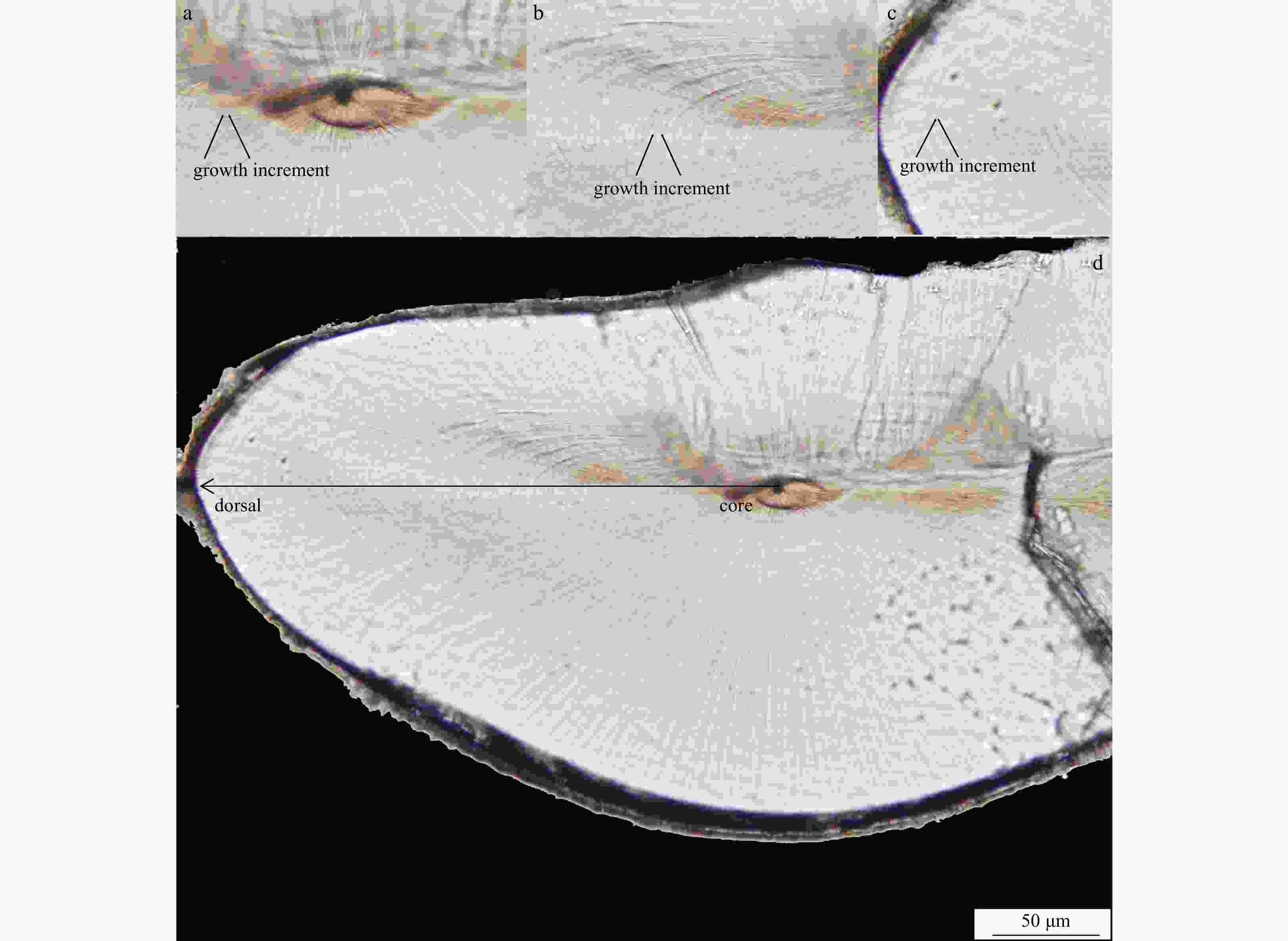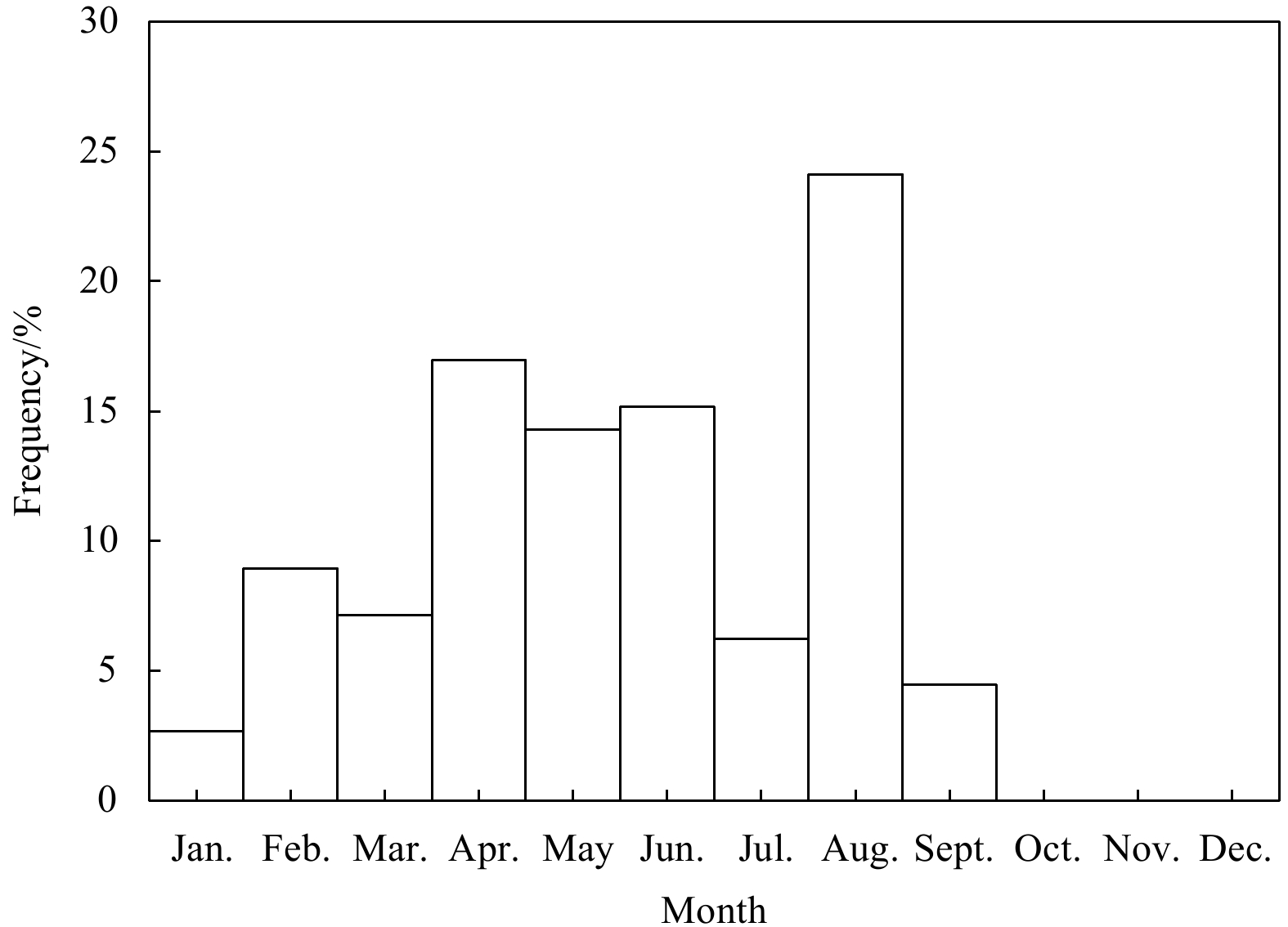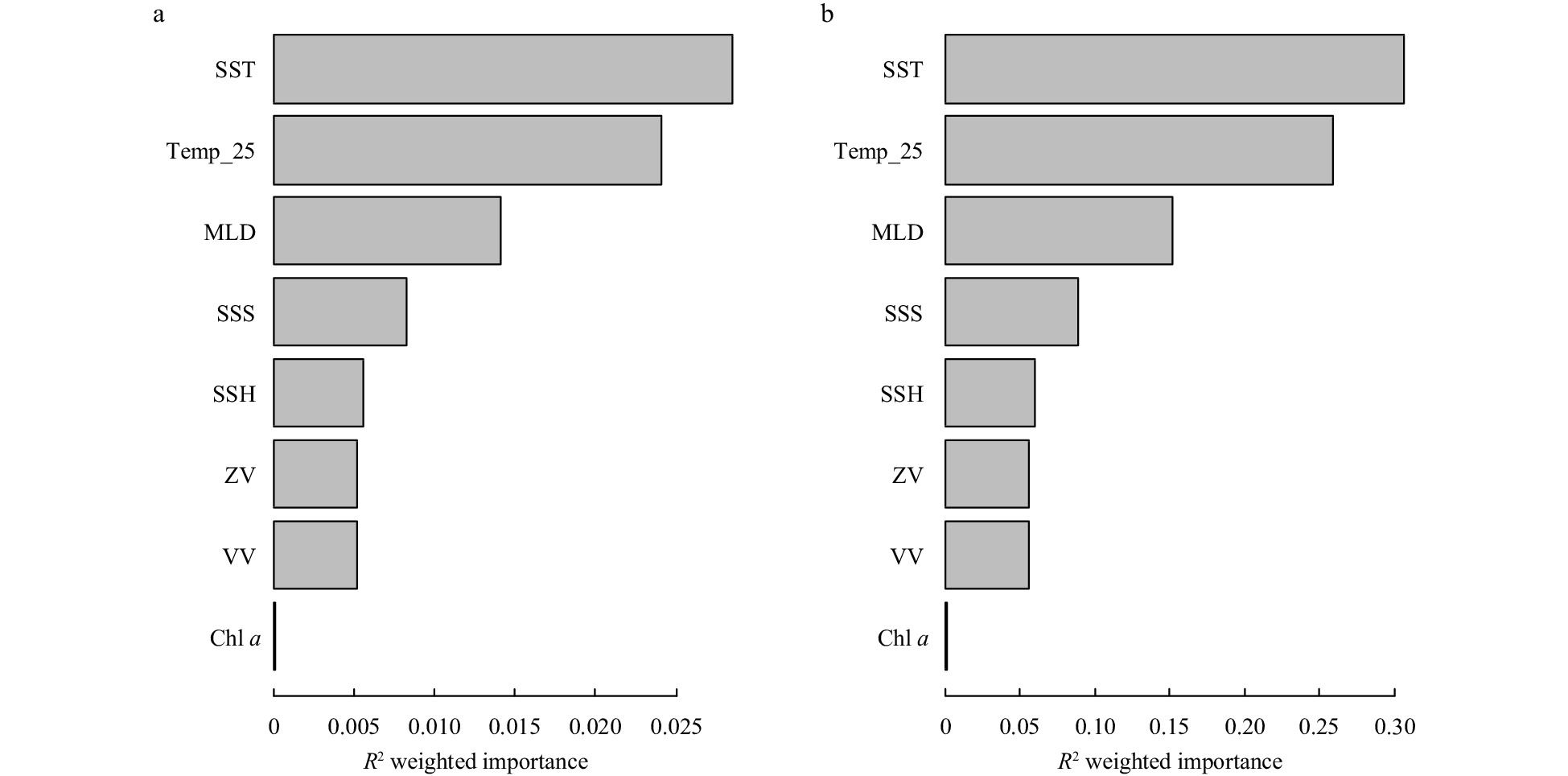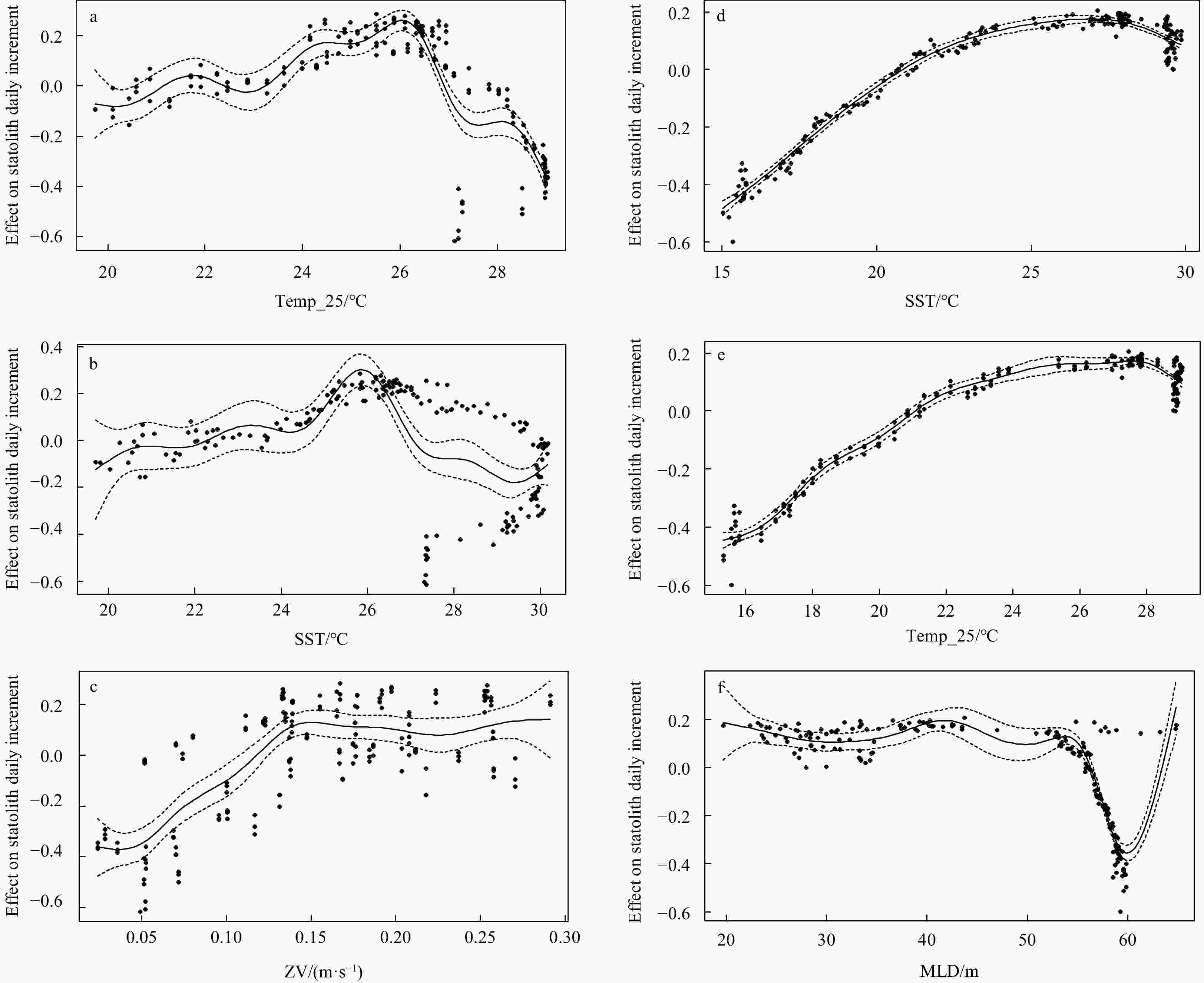Relationships between daily growth of different groups of swordtip squid (Uroteuthis edulis) and environmental variables in the East China Sea
-
Abstract: Swordtip squid (Uroteuthis edulis) is one of the important economical fishing target species in the East China Sea. Uroteuthis edulis is characterized by rapid growth, extensive migration, and long spawning period and sensitive to surrounding environment. In order to assess its stock status, it is necessary to explore its spawning season, growth patterns of different populations and their relationship with the environment in advance. In this paper, based on the samples of U. edulis collected in the East China Sea from September 2017 to March 2018, we explored the relationships between daily growth of statolith microstructure and environmental variables by gradient forest method and generalized additive model. The spawning season of U. edulis was found to be nearly one year, and two dominant season groups were found: the spring group with the peak period of April and the summer group with the peak period of August. Water temperature in the depth of 25 m (Temp_25), sea surface temperature (SST) and zonal velocity were the key environmental variables for the daily growth of April-spawning group. The most suitable environmental conditions for the growth of April-spawning group were water temperature (24−27°C) and velocity (0.1−0.3 m/s). SST, Temp_25 and mixed layer depth were the key environment variables for the daily growth of August-spawning group. The most suitable environmental conditions for the growth of August-spawning group were water temperature (21−28°C) and water depth (0−50 m). Key environmental variables of different groups suggested that early growth was significantly affected by seasonal changes of water temperature, current velocity and prey abundance. This study explored the relationships between early growth and environmental variables and provided the scientific guidance for the management and conservation of U. edulis.
-
Key words:
- East China Sea /
- Uroteuthis edulis /
- statolith microstructure /
- environmental variables
-
Figure 7. Importance of environmental variables in response to mean daily increment width of April-spawning group (a) and August-spawning group (b) in 2017. SST is the abbreviation of sea surface temperature; Temp_25, water temperature at depth of 25 m; MLD, mix layer depth; SSS, sea surface salinity; SSH, sea surface height; VV, vertical current velocity; ZV, zonal current velocity; Chl a, chlorophyll a concentration.
Figure 8. Cumulative importance of environmental variables in relation to daily increment width of statolith for April-spawning group (a−c) and August-spawning group (d−f). Temp_25 is the abbreviation of water temperature at the depth of 25 m; SST, sea surface temperature; ZV, zonal current velocity; MLD, mix layer depth.
Figure 9. Effective of environmental variables on daily increment width for April-spawning group (a−c) and August-spawning group (d−f) based on generalized additive model (GAM) analyses. Temp_25 is the abbreviation of water temperature at the depth of 25 m; SST, sea surface temperature; ZV, zonal current velocity; MLD, mix layer depth.
Table 1. Sampling information of Uroteuthis edulis from the East China Sea
Sampling time Location Number Mantle length range/mm Age range/d Sex ratio
F:MSeptember 2017 30°30' N,
127°00' E15 69−198 176−224 1.4:1 November 2017 31°00' N,
126°30' E19 110−234 175−273 0.9:1 December 2017 31°30' N,
126°30' E23 86−223 153−254 1.2:1 January
201831°30' N,
127°00' E24 93−180 175−228 1:1 February 2018 28°30' N,
123°00' E17 87−158 176−233 2:1 March
201827°30' N,
124°30' E23 92−154 169−215 0.7:1 Note: F:M represents female amount vs. male amount. Table 2. Descriptions of environmental variables
Environmental variable Description SST sea surface temperature Temp_25 water temperature at the depth of 25 m MLD mixed layer depth SSH sea surface height SSS sea surface salinity Chl a chlorophyll a concentration ZV zonal current velocity VV vertical current velocity Table 3. Key environmental variables of April- and August-spawning groups identified based on the analysis results of the generalized additive model (GAM)
Group Environmental variable AIC R2 Deviance explained/% P-value Significance April-spawning Temp_25 −238.50 0.72 73.1 0.000 *** SST −106.51 0.40 43.0 0.000 *** ZV −165.57 0.57 58.6 0.000 *** Temp_25+ZV −299.13 0.81 82.6 0.000 *** SST+ZV −239.13 0.72 73.8 0.000 *** August-spawning SST −674.92 0.97 97.1 0.000 *** Temp_25 −651.80 0.96 96.8 0.000 *** MLD −348.80 0.82 82.5 0.000 *** Note: AIC is the abbreviation of Akaike Information Criterion; Temp_25, water temperature at the depth of 25 m; SST, sea surface temperature; ZV, zonal current velocity; MLD, mix layer depth. Model significance: *, P<0.05; **, P<0.001; and ***, P<0.000 1. Environmental variables in bold are the highest goodness-of-fit based on GAM. -
[1] Alabia I D, Dehara M, Saitoh S I, et al. 2016. Seasonal habitat patterns of Japanese common squid (Todarodes pacificus) inferred from satellite-based species distribution models. Remote Sensing, 8(11): 921. doi: 10.3390/rs8110921 [2] Arkhipkin A I. 2005. Statoliths as ‘black boxes’ (life recorders) in squid. Marine and Freshwater Research, 56(5): 573–583. doi: 10.1071/MF04158 [3] Arkhipkin A I, Bizikov V A, Doubleday Z A, et al. 2018. Techniques for estimating the age and growth of molluscs: Cephalopoda. Journal of Shellfish Research, 37(4): 783–792. doi: 10.2983/035.037.0409 [4] Arkhipkin A I, Shcherbich Z N. 2012. Thirty years’ progress in age determination of squid using statoliths. Journal of the Marine Biological Association of the United Kingdom, 92(6): 1389–1398. doi: 10.1017/S0025315411001585 [5] Bounket B, Gibert P, Gennotte V, et al. 2019. Otolith shape analysis and daily increment validation during ontogeny of larval and juvenile European chub Squalius cephalus. Journal of Fish Biology, 95(2): 444–452. doi: 10.1111/jfb.13976 [6] Ceriola L, Jackson G D. 2010. Growth, hatch size and maturation in a southern population of the loliginid squid Loliolus noctiluca. Journal of the Marine Biological Association of the United Kingdom, 90(4): 755–767. doi: 10.1017/S0025315409991445 [7] Chen Chih-Shin, Chen Jing-yu, Lin Chiao-Wen. 2015. Variation in life-history traits for micro-cohorts of Sepioteuthis lessoniana in the waters off northern Taiwan. Fisheries Science, 81(1): 53–64. doi: 10.1007/s12562-014-0831-x [8] Chen Xinjun, Liu Bilin, Fang Zhou, et al. 2019. Cephalopoda. Beijing: China Ocean Press, 375–380 [9] Chen Xinjun, Tian Siquan, Liu Bilin, et al. 2011. Modeling a habitat suitability index for the eastern fall cohort of Ommastrephes bartramii in the central North Pacific Ocean. Chinese Journal of Oceanology and Limnology, 29(3): 493–504. doi: 10.1007/s00343-011-0058-y [10] Ellis N, Smith S J, Pitcher C R. 2012. Gradient forests: calculating importance gradients on physical predictors. Ecology, 93(1): 156–168. doi: 10.1890/11-0252.1 [11] Fang Zhou, Chen Xinjun, Su Hang, et al. 2018. Exploration of statolith shape variation in jumbo flying squid, Dosidicus gigas, based on wavelet analysis and machine learning methods for stock classification. Bulletin of Marine Science, 94(4): 1465–1482. doi: 10.5343/bms.2017.1176 [12] Fang Zhou, Li Jianhua, Thompson K, et al. 2016. Age, growth, and population structure of the red flying squid (Ommastrephes bartramii) in the North Pacific Ocean, determined from beak microstructure. Fishery Bulletin, 114(1): 34–44. doi: 10.7755/FB.114.1.3 [13] Fang Zhou, Liu Bilin, Chen Xinjun, et al. 2019. Ontogenetic difference of beak elemental concentration and its possible application in migration reconstruction for Ommastrephes bartramii in the North Pacific Ocean. Acta Oceanologica Sinica, 38(10): 43–52. doi: 10.1007/s13131-019-1431-5 [14] Hao Jiajia, Chen Yongli, Wang Fan. 2012. Long-term variability of the sharp thermocline in the Yellow and East China Seas. Chinese Journal of Oceanology and Limnology, 30(6): 1016–1025. doi: 10.1007/s00343-012-1251-3 [15] Jackson G D. 2004. Advances in defining the life histories of myopsid squid. Marine and Freshwater Research, 55(4): 357–365. doi: 10.1071/MF03152 [16] Jereb P, Roper C F E. 2010. Cephalopods of the World. An Annotated and Illustrated Catalogue of Cephalopod Species Known to Date. Volume 2. Myopsid and Oegopsid Squids. Rome: Food and Agriculture Organization of the United Nations, 98–117 [17] Jin Yue, Li Na, Chen Xinjun, et al. 2019. Comparative age and growth of Uroteuthis chinensis and Uroteuthis edulis from China Seas based on statolith. Aquaculture and Fisheries, 4(4): 166–172. doi: 10.1016/j.aaf.2019.02.002 [18] Kako S I, Nakagawa T, Takayama K, et al. 2016. Impact of Changjiang River discharge on sea surface temperature in the East China Sea. Journal of Physical Oceanography, 46(6): 1735–1750. doi: 10.1175/JPO-D-15-0167.1 [19] Kikko T, Ishizaki D, Yodo T, et al. 2019. Daily growth increments in otoliths of wild-caught honmoroko Gnathopogon caerulescens. Journal of Fish Biology, 95(2): 668–672. doi: 10.1111/jfb.14008 [20] Kurota H, Szuwalski C S, Ichinokawa M. 2020. Drivers of recruitment dynamics in Japanese major fisheries resources: effects of environmental conditions and spawner abundance. Fisheries Research, 221: 105353. doi: 10.1016/j.fishres.2019.105353 [21] Liao Cheng-Hsin, Lan Kuo-Wei, Ho Hsi-Ying, et al. 2018. Variation in the catch rate and distribution of swordtip squid Uroteuthis edulis associated with factors of the oceanic environment in the southern East China Sea. Marine and Coastal Fisheries, 10(4): 452–464. doi: 10.1002/mcf2.10039 [22] Liu Bilin, Chen Yong, Chen Xinjun. 2015. Spatial difference in elemental signatures within early ontogenetic statolith for identifying Jumbo flying squid natal origins. Fisheries Oceanography, 24(4): 335–346. doi: 10.1111/fog.12112 [23] Liu Bilin, Chen Xinjun, Lu Huajie, et al. 2011. Cephalopod Statolith. Beijing: China Ocean Press, 23–160 [24] Miyahara K, Ota T, Goto T, et al. 2006. Age, growth and hatching season of the diamond squid Thysanoteuthis rhombus estimated from statolith analysis and catch data in the western Sea of Japan. Fisheries Research, 80(2–3): 211–220. doi: 10.1016/j.fishres.2006.04.014 [25] Moreno A, Pierce G J, Azevedo M, et al. 2012. The effect of temperature on growth of early life stages of the common squid Loligo vulgaris. Journal of the Marine Biological Association of the United Kingdom, 92(7): 1619–1628. doi: 10.1017/S0025315411002141 [26] Morgan E, O’Riordan R M, Culloty S C. 2013. Climate change impacts on potential recruitment in an ecosystem engineer. Ecology and Evolution, 3(3): 581–594. doi: 10.1002/ece3.419 [27] Natsukari Y, Tashiro M. 1991. Neritic squid resources and cuttlefish resources in Japan. Marine Behaviour and Physiology, 18(3): 149–226. doi: 10.1080/10236249109378785 [28] Pang Yumeng, Tian Yongjun, Fu Caihong, et al. 2018. Variability of coastal cephalopods in overexploited China Seas under climate change with implications on fisheries management. Fisheries Research, 208: 22–33. doi: 10.1016/j.fishres.2018.07.004 [29] Pecl G T. 2004. The in situ relationships between season of hatching, growth and condition in the southern calamary, Sepioteuthis australis. Marine and Freshwater Research, 55(4): 429–438. doi: 10.1071/MF03150 [30] Pecl G T, Jackson G D. 2008. The potential impacts of climate change on inshore squid: biology, ecology and fisheries. Reviews in Fish Biology and Fisheries, 18(4): 373–385. doi: 10.1007/s11160-007-9077-3 [31] Polito P S, Sato O T, Liu W T. 2000. Characterization and validation of the heat storage variability from TOPEX/Poseidon at four oceanographic sites. Journal of Geophysical Research: Oceans, 105(C7): 16911–16921. doi: 10.1029/1999JC000048 [32] Rosa R, Seibel B A. 2008. Synergistic effects of climate-related variables suggest future physiological impairment in a top oceanic predator. Proceedings of the National Academy of Sciences of the United States of America, 105(52): 20776–20780. doi: 10.1073/pnas.0806886105 [33] Şen H. 2005. Incubation of European Squid (Loligo vulgaris Lamarck, 1798) eggs at different salinities. Aquaculture Research, 36(9): 876–881. doi: 10.1111/j.1365-2109.2005.01296.x [34] Sin Y W, Yau C, Chu Ka Hou. 2009. Morphological and genetic differentiation of two loliginid squids, Uroteuthis (Photololigo) chinensis and Uroteuthis (Photololigo) edulis (Cephalopoda: Loliginidae), in Asia. Journal of Experimental Marine Biology and Ecology, 369(1): 22–30. doi: 10.1016/j.jembe.2008.10.029 [35] Sun Peng, Chen Qi, Fu Caihong, et al. 2020. Daily growth of young-of-the-year largehead hairtail (Trichiurus japonicus) in relation to environmental variables in the East China Sea. Journal of Marine Systems, 201: 103243. doi: 10.1016/j.jmarsys.2019.103243 [36] Takahara H, Kidokoro H, Sakurai Y. 2017. High temperatures may halve the lifespan of the Japanese flying squid, Todarodes pacificus. Journal of Natural History, 51(43–44): 2607–2614. doi: 10.1080/00222933.2016.1244297 [37] Wang Kae-Yih. 2009. Life history of Uroteuthis (Photololigo) edulis (Hoyle, 1885) in the Shelf Waters off Northeastern Taiwan (in Chinese) [dissertation]. Taiwan, China: National Taiwan Ocean University [38] Wang Kae-Yih, Chang Ke-yang, Liao Cheng-Hsin, et al. 2013. Growth Strategies of the Swordtip Squid, Uroteuthis Edulis, in response to environmental changes in the southern East China Sea—a cohort analysis. Bulletin of Marine Science, 89(3): 677–698. doi: 10.5343/bms.2012.1044 [39] Wang Kai-Yih, Chen Jyun-long, Liao Cheng-hsin. 2015a. Use of a generalized additive model to examine factors influencing the CPUE of Uroteuthis edulis. Journal of the Fisheries Society of Taiwan, 42(2): 73–85 [40] Wang Kae-Yih, Lee Kuo-Tien, Liao Cheng-Hsin. 2010. Age, growth and maturation of swordtip squid (Photololigo edulis) in the southern East China Sea. Journal of Marine Science and Technology, 18(1): 12 [41] Wang Jintao, Yu Wei, Chen Xinjun, et al. 2015b. Detection of potential fishing zones for neon flying squid based on remote-sensing data in the Northwest Pacific Ocean using an artificial neural network. International Journal of Remote Sensing, 36(13): 3317–3330. doi: 10.1080/01431161.2015.1042121 [42] Xing Qinwang, Yu Huaming, Yu Haiqing, et al. 2020. A comprehensive model-based index for identification of larval retention areas: a case study for Japanese anchovy Engraulis japonicus in the Yellow Sea. Ecological Indicators, 116: 106479. doi: 10.1016/j.ecolind.2020.106479 [43] Yamaguchi T, Aketagawa T, Miyamoto M, et al. 2018a. The use of statolith analyses and particle-tracking experiments to reveal the migratory route of the swordtip squid (Uroteuthis edulis) caught on the Pacific side of Japan. Fisheries Oceanography, 27(6): 517–524. doi: 10.1111/fog.12270 [44] Yamaguchi T, Aketagawa T, Takayama K, et al. 2019. Migratory routes of different sized swordtip squid (Uroteuthis edulis) caught in the Tsushima Strait. Fisheries Research, 209: 24–31. doi: 10.1016/j.fishres.2018.08.008 [45] Yamaguchi T, Kawakami Y, Matsuyama M. 2015. Migratory routes of the swordtip squid Uroteuthis edulis inferred from statolith analysis. Aquatic Biology, 24(1): 53–60. doi: 10.3354/ab00635 [46] Yamaguchi T, Kawakami Y, Matsuyama M. 2018b. Analysis of the hatching site and migratory behaviour of the swordtip squid (Uroteuthis edulis) caught in the Japan Sea and Tsushima Strait in autumn estimated by statolith analysis. Marine Biology Research, 14(1): 105–112. doi: 10.1080/17451000.2017.1351616 [47] Yamaguchi T, Takayama K, Hirose N, et al. 2020. Relationship between empirical water temperature and spring characteristics of swordtip squid (Uroteuthis edulis) caught in the eastern Tsushima Strait. Marine Biology Research, 16(2): 93–102. doi: 10.1080/17451000.2020.1712420 [48] Yu Wei, Chen Xinjun, Yi Qian, et al. 2015. Variability of suitable habitat of western winter-spring cohort for neon flying squid in the Northwest Pacific under anomalous environments. PLoS ONE, 10(4): e0122997. doi: 10.1371/journal.pone.0122997 [49] Yu Wei, Chen Xinjun, Yi Qian, et al. 2016. Influence of oceanic climate variability on stock level of western winter–spring cohort of Ommastrephes bartramii in the Northwest Pacific Ocean. International Journal of Remote Sensing, 37(17): 3974–3994. doi: 10.1080/01431161.2016.1204477 [50] Zumholz K, Hansteen T H, Piatkowski U, et al. 2007. Influence of temperature and salinity on the trace element incorporation into statoliths of the common cuttlefish (Sepia officinalis). Marine Biology, 151(4): 1321–1330. doi: 10.1007/s00227-006-0564-1 -





 下载:
下载:











